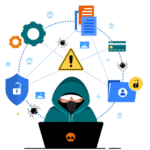Table of Contents
- Introduction: Security Starts with Identity
- What is Identity Governance?
- Why Identity Governance Matters More Than Ever
- Identity Governance vs Identity and Access Management (IAM)
- Core Components of Identity Governance
- Key Benefits of Identity Governance
- Common Identity Governance Challenges (And How to Overcome Them)
- Identity Governance Use Cases
- Implementing Identity Governance: A Step-by-Step Guide
- The Future of Identity Governance
- Final Thoughts: Don’t Let Identities Become Liabilities
Introduction: Security Starts with Identity
In today’s digitized business landscape, data breaches are no longer a matter of if—they’re a matter of when. While firewalls, endpoint detection, and threat intelligence tools are essential, they are reactive in nature. To build a truly proactive defense strategy, enterprises must focus on the one thing every security incident has in common: identity.
Identity governance—often overlooked in traditional security planning—is emerging as the first line of defense against cyber threats. It ensures the right people have the right access to the right resources at the right time—and that their access is constantly monitored, reviewed, and revoked when necessary.
This article explores why identity governance is critical to enterprise security, how it works, its core benefits, and how you can implement an effective governance strategy for your organization.
What is Identity Governance?
Identity Governance is a framework for managing digital identities and access rights across an organization. It combines processes, policies, and technologies to control who has access to what, under what circumstances, and for how long.
At its core, identity governance answers four essential questions:
- Who has access?
- What do they have access to?
- Why do they have access?
- Should they still have access?
It provides visibility into identity lifecycle management, enforces compliance policies, and reduces the risks of insider threats or over-privileged users.
Why Identity Governance Matters More Than Ever
As enterprises shift to hybrid and remote work models and adopt cloud services at scale, identity sprawl becomes a major risk. Employees, contractors, vendors, and automated systems may hold credentials to sensitive systems—often without oversight.
Here’s why identity governance is now a business imperative:
🔐 1. Rising Insider Threats
Not all breaches come from outsiders. Employees with excessive access can accidentally—or maliciously—expose confidential data.
☁️ 2. Cloud Complexity
With workloads across multiple SaaS platforms, IAM (Identity and Access Management) alone is not enough. Governance ensures cross-platform policy enforcement.
🏛️ 3. Compliance Pressure
Frameworks like GDPR, HIPAA, SOX, and ISO 27001 demand strict controls on data access and auditability.
🔄 4. Dynamic Workforces
Joiners, movers, and leavers cycles are frequent. Without governance, former employees may retain access indefinitely.
Identity Governance vs Identity and Access Management (IAM)
While often used interchangeably, identity governance and IAM serve different functions:
| Feature | IAM | Identity Governance |
|---|---|---|
| Purpose | Grant and manage access | Monitor, review, and audit access |
| Focus | Operational (authentication/SSO) | Strategic (risk/compliance) |
| Example Tools | Okta, Azure AD | SailPoint, Saviynt, One Identity |
| Control Mechanism | Access provisioning | Access reviews, certifications |
| Goal | Enable access | Govern access to reduce risk |
In short: IAM opens the doors, while identity governance decides who should walk through them—and when to lock them.
Core Components of Identity Governance
To build an effective identity governance framework, enterprises need these foundational elements:
➤ 1. Identity Lifecycle Management
Automates provisioning, de-provisioning, and updating user access based on job roles and employment status.
➤ 2. Access Certification
Regular reviews that validate whether users still need access to specific systems, especially high-risk resources.
➤ 3. Policy Enforcement
Applies role-based access control (RBAC), least privilege, and segregation of duties (SoD) to minimize risk exposure.
➤ 4. Role Management
Defines access rights based on job functions to ensure consistent permissions without manual errors.
➤ 5. Access Request and Approval Workflows
Allows users to request access with automated multi-level approval routing—enhancing both efficiency and control.
➤ 6. Audit & Reporting
Maintains detailed logs and reports to support compliance audits, incident response, and internal governance reviews.
Key Benefits of Identity Governance
✅ 1. Reduced Attack Surface
By ensuring only the right people have access to sensitive systems, the number of potential entry points for attackers is drastically reduced.
✅ 2. Streamlined Compliance
Automated access reviews and robust audit trails make it easier to meet requirements for regulations like GDPR, HIPAA, SOX, and others.
✅ 3. Enhanced Operational Efficiency
Identity governance automates time-consuming manual tasks like onboarding, deprovisioning, and periodic access reviews.
✅ 4. Improved Visibility
Provides security teams with a comprehensive, centralized view of who has access to what, allowing for quicker risk assessments.
✅ 5. Faster Incident Response
In the event of a breach, identity governance tools enable rapid access revocation and traceability of user activities.

Common Identity Governance Challenges (And How to Overcome Them)
❌ 1. Role Explosion
As companies scale, they often create too many roles, leading to confusion and overlapping privileges.
Solution: Implement dynamic role mining and rationalization using tools like SailPoint or Saviynt.
❌ 2. Shadow IT
Users often adopt unauthorized apps, creating blind spots in access visibility.
Solution: Use cloud access security brokers (CASBs) and integrate them with your governance solution.
❌ 3. Manual Reviews
Access certifications conducted via spreadsheets are inefficient and error-prone.
Solution: Automate reviews with scheduled workflows and automated reminders.
❌ 4. Resistance from Users
Some employees view governance as restrictive or unnecessary.
Solution: Communicate the value of governance in protecting the organization and empowering users with self-service access requests.
Identity Governance Use Cases
🔹 Onboarding & Offboarding Automation
Provision access immediately when an employee joins, and revoke it instantly upon departure.
🔹 Access Review Campaigns
Schedule quarterly access reviews for critical applications, such as finance or HR systems, with line-manager approvals.
🔹 Segregation of Duties (SoD)
Prevent users from having conflicting permissions, such as initiating and approving the same transaction in ERP systems.
🔹 Third-Party Vendor Management
Control and monitor access for external contractors, ensuring their access expires when their contracts end.
Implementing Identity Governance: A Step-by-Step Guide
Step 1: Assess Current State
- Audit all identities, roles, and entitlements
- Identify redundant or excessive permissions
Step 2: Define Governance Policies
- Set rules for role creation, access review frequency, and SoD
- Determine approval hierarchies
Step 3: Select the Right Tool
Popular platforms include:
- SailPoint – Advanced policy management, AI-driven insights
- Saviynt – Cloud-native, scalable governance
- One Identity – Strong integration with Active Directory
- IBM Security Identity Governance – Great for hybrid environments
Step 4: Integrate with Identity Sources
Connect your IAM platform, HR system, ERP, and major applications for end-to-end governance coverage.
Step 5: Automate Workflows
Automate joiner-mover-leaver processes, access request approvals, and review reminders.
Step 6: Train & Communicate
Educate employees, managers, and admins on governance processes and their responsibilities.
Step 7: Monitor & Iterate
Continuously monitor access patterns, refine roles, and improve certification workflows.
The Future of Identity Governance
🔮 AI-Driven Access Intelligence
Machine learning is being used to detect anomalous access patterns, recommend least-privilege roles, and predict risky behaviors.
🔮 Zero Trust Alignment
Identity governance plays a foundational role in the Zero Trust model, where no user or device is trusted by default.
🔮 Identity as the New Perimeter
As perimeters blur, identity becomes the control plane—governing access based on context, risk, and intent.
Final Thoughts: Don’t Let Identities Become Liabilities
In an era where a single compromised credential can cost millions, identity governance isn’t just an IT responsibility—it’s a business-critical mandate.
By putting identity governance at the heart of your enterprise security strategy, you gain visibility, control, and resilience. You move from reactive to proactive. And most importantly, you give your security teams the confidence to say: yes, we know who has access—and we know why.
When identity is governed well, it becomes your first and most powerful line of defense.








Leave a Reply